#the saga of ragnar lodbrok
Text
LA EDAD DE ORO DE LOS “REYES DEL MAR”
LA EDAD DE ORO DE LOS “REYES DEL MAR”

View On WordPress
#bjkon costado de hierro#ivan el deshuesado#ivan el deshuesado ubbe y halfdan#olav haraldsson#ragnar lodbrok#rollón el caminante#sagas vikingas#vikingos
1 note
·
View note
Text
Every Pagan Holiday
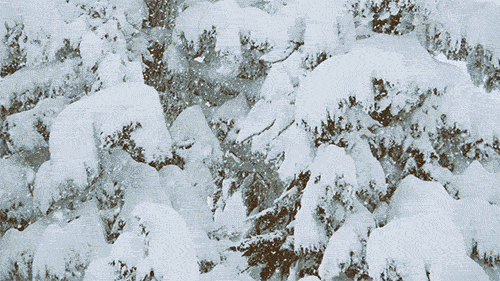
JANUARY
KALENDS
1st January
Origins: Ancient Greece/Rome
Observed by: Hellenic/Roman polytheists
Honouring Janus/Juno, first day of the Year. Kalends brought us the word 'calendar'.
ÞORRABLÓT (THORRABLÓT)
End of January/beginning of February
Origins: Iceland
Observed by: Heathens, Asatru
Midwinter Festival honouring Thor, usually by feasting and poetry.

FEBRUARY
IMBOLC
2nd February
Origins: Celtic polytheism /Ireland, as St. Brigid's Day
Observed by: Most neopagans, Wiccans, Druids, Asatru (as Charming of the Plow)
Imbolc is the most widely known and observed pagan holiday in the months of January and February. It falls at the beginning of spring/end of the winter for the Celtic peoples; marking the changing of the seasons, as most holidays do. St. Brigid is a Christianised form of or inspired by the Celtic fertility goddess Brigid who is celebrated on this day.
PARENTALIA
13th-21st February
Origins: Ancient Rome
Observed by: Greco-Roman polytheists
Translating to 'Ancestors Day', Parentalia is a nine-day celebration of deceased ancestors. Historically it was observed by feasting and making offerings and sacrifices to the dead and spirits of the underworld.
VÁLI'S BLOT
14th February
Origins: Old Norse
Observed by: Heathens, Asatru, Norse polytheists
Váli's Blot is considered by some Asatru to be the Norse equivalent of Valentine's Day but is widely acknowledged as a season changing festival. A day for marriage and celebrating with family and friends, and for remembrance of Váli, the son of Odin who defeated Höðr on this day.
LUPERCALIA
15th February
Origins: Ancient Rome
Observed by: Greco-Roman polytheists
Festival thought to honour a wolf who raised abandoned princes, celebrated originally by sacrificing goats to the gods, feasting, and, for fertility, nudity and fornication.
LESSER ELEUSINIAN MYSTERIES
17th-23rd February
Origins: Ancient Greece
Observed by: Hellenic polytheists
Initiation to the cult of Persephone and Demeter by sacrificing a pig. Prelude to Greater Mysteries, initiations held on these dates. Once completed, initiates could then move onto Greater Mysteries in the autumn.
ANTHESTERIA
27th February - 1st March 2021
Origins: Ancient Greece
Observed by: Hellenic polytheists
Athenian festivals dedicated to Dionysus and the dead. Held around the full moon in the month of Anthesterion, which in the Gregorian calendar this year roughly translates to 27th February.
THE DISTING/DÍSABLÓT
End of February/beginning of March
Origins: Uppsala, Sweden
Observed by: Heathens, Asatru, Norse polytheists
Celebration of Valkyries and other female spirits, called dísir. Sacrifices were made for a good harvest. Celebrated still by an annual market in Sweden.

MARCH
KALENDS
1st March
Origins: Ancient Greece/Rome
Observed by: Hellenic/Roman polytheists
Honouring the god Mars/Ares. Kalends brought us the word 'calendar'.
OSTARA/EARRACH
20th March
Origins: Anglo Saxon paganism, popularised as Ostara by Wicca
Observed by: Anglo Saxon Pagans, Wiccans, Neopagans, Druids (as Alba Eilir), Heathens (as Summer Finding), Ásatrú (as Sigrblót)
The northern hemisphere's vernal equinox, the word Ostara was introduced though Wicca and named for the goddess Eostre. Surprisingly unrelated to Easter in all but name, Ostara symbolises the beginning of spring. As a seasonal holiday it is widely celebrated by many different groups of pagans.
RAGNAR LODBROK'S DAY
28th March
Origins: Icelandic Sagas
Observed by: Ásatrú
Day of remembrance for Ragnar Lodbrok, Viking King of legend

APRIL
KALENDS/VENERALIA
1st April
Origins: Ancient Greece/Rome
Observed by: Hellenic/Roman polytheists
Celebration of the first of the month, this one honouring the goddess, Venus.
REMEMBRANCE FOR HAAKON SIGURDSSON
9th April
Origins: Norway, C9th
Observed by: Ásatrú
Day of remembrance for ruler of Norway who claimed lineage to Odin in the Icelandic Sagas.
WALPURGISNACHT
30th April
Origins: German Christianity, originally Saint Walpurga was known for banishing witches and other pests
Observed by: LaVeyan Satanists
Anton LaVey chose to celebrate this holiday as a follow up to the spring equinox and due to its past association with witchcraft.
HEXENNACHT (WITCHES' NIGHT)
30th April
Origins: German folklore, as Walpurgisnacht but witches were alleged to convene with the devil in this night
Observed by: Temple of Satan as 'a solemn holiday to honour those who were victimized by superstition'.

MAY
BEALTAINE/BELTANE
1st May
Origins: Celtic (Ireland/Scotland/Isle of Man)
Observed by: Wiccans, Neopagans, Celtic reconstructionist, Ásatrú/Heathens (as May Day)
One of the more well-known pagan festivals, Beltane is a festival of fire and the beginning of the summer. Also widely referred to as May Day, it is celebrated by lighting fires.
KALENDS
1st May
Origins: Ancient Greece/Rome
Observed by: Hellenic/Roman polytheists
Honouring the goddess Maia, for whom the month may have been named.
REMEMBRANCE FOR Guðröðr of Guðbrandsdál
9th May
Origins: C11 Norway, Icelandic Sagas
Observed by: Ásatrú, Norse, heathens
Guðröðr had his tongue removed by Óláfr for rebelling against violent conversion from Norse paganism to Christianity.
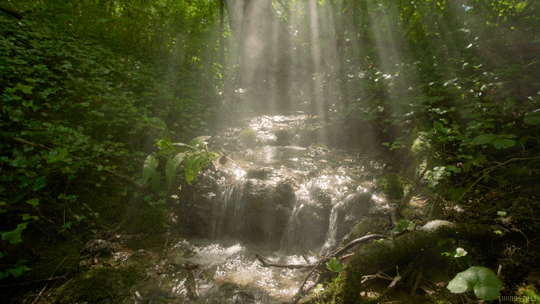
JUNE
KALENDS
1st June
Origins: Ancient Greece/Rome
Observed by: Hellenic/Roman polytheists
Anniversary of temples to Juno Moneta (protectress of money, her temple was where coins were made), Mars/Ares (God of war), and the Tempestates (goddesses of storms).
ARRHEPHORIA
3rd Skirophorion (translates to mid-June)
Origins: Ancient Greece
Observed by: Hellenic reconstructionist
Feast in celebration of Athena and fertility.
MIDSUMMER/SUMMER SOLSTICE
21st June
Origins: Agricultural holiday/longest day observed for centuries by many civilisations. Christianity can date to as early as C4th
Observed by: Wiccans/Germanic neopagans (as Litha), Asatru/Heathens, Druids (as Alban Hefin)
One of the main four holidays in the Wheel of the Year and popularised by Wiccans and neopagans as Litha which is taken from the Anglo-Saxon words for June/July, this is the longest day of the year and the middle point and sometimes considered the beginning of summer.

JULY
REMEMBRANCE FOR UNNR/AUD THE DEEP MINDED
9th July
Origins: C9th Iceland
Observed by: Ásatrú, Heathens, Norse reconstructionist
Aud was a traveller in the 9th century moving between Dublin, the Hebrides, Orkney, and finally Iceland following the deaths of her husband and son. This day is to honour her memory.
HERACLEIA
July/August
Origins: Ancient Greece
Observed by: Hellenic polytheists
Festival dedicated to Heracles the demigod and his death, involving feasting and celebration.

AUGUST
LUGHNASADH/LAMMAS
1st August
Origins: Celtic Britain (Ireland, Scotland, Isle of Man)
Observed by: Wiccans, Neopagans, Christians (as Lammas), Ásatrú (as Freyfaxi)
Named for the god Lugh, this festival is one of the Celtic harvest festivals and marks the beginning of the harvesting months. It was celebrated by climbing mountains, bull sacrifice, offerings, and feasting. Handfasting is commonplace with Wiccans in modern times.
REMEMBRANCE FOR REDBAD, KING OF THE FRISIANS
9th August
Origins: C7th Frisia (area of Germany/Netherlands)
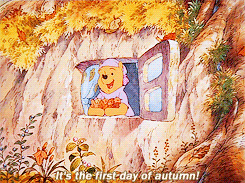
SEPTEMBER
NOUMENIA
8th September
Origins: Ancient Greece
Observed by: Hellenic polytheists
Celebration of new Hellenic lunar month. Offerings of honey and incense made to household deities.
REMEMBRANCE FOR HERMANN THE CHERUSCAN
9th September
Origins: C9th CE
Observed by: Heathens, Ásatrú
Hermann the Cheruscan, also known as Arminius of the Cherusci tribe, led the defeat against the Romans at the Battle of Teutoburg Forest and is lauded for saving Eastern Germanic peoples from being conquered by the Roman Empire.
AUTUMN EQUINOX (NORTHERN HEMISPHERE)
22nd September
Origins: 1970s neopaganism
Observed by: Wiccans and Neopagans (as Mabon), Ásatrú (as Winter Finding)
Named Mabon by prominent Wicca and Neopagan Aidan Kelly, after the Welsh mythological figure Mabon ap Moldron, the autumn equinox is one of the harvest festivals and marks the beginning of autumn in the northern hemisphere. Mabon is a relatively new pagan holiday not based on any specific historical festival, but traditionally people around the world would celebrate some kind of harvest festival around the end of September/beginning of October.
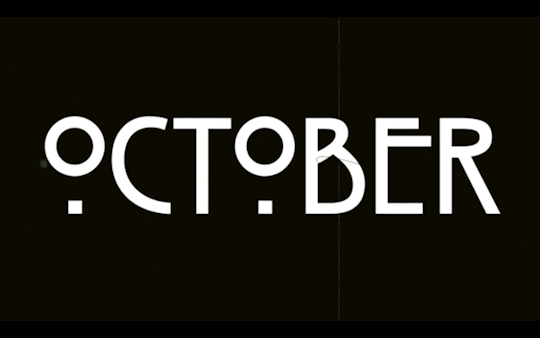
OCTOBER
PYANOPSIA
7th October
Origins: Ancient Greece
Observed by: Hellenic polytheists
Pyanopsia, or Pyanepsia, is a festival to honour Apollo, one of the most important deities, God of music, the sun, knowledge, healing, and archery - amongst other things. During the festival, two special offerings would be placed on doorways and carried to the temple. These offerings were a bean stew, and an olive branch wrapped in wool with honeys, pastries and seasonal fruits hanging from it.
REMEMBRANCE FOR LEIF EIRIKSSON
9th October
Origins: C10th CE
Observed by: Heathens, Ásatrú, Norse pagans
Remembrance for Leif and his sister Freydís Eiríksdóttir, children of Erik the Red, who are cited with being the first Norse explorers in North America.
THESMOPHORIA
12th-14th October
Origins: Ancient Greece
Observed by: Hellenic polytheists
Festival held in honour of Demeter Thesmophoros, goddess of agriculture, and her daughter Persephone, goddess of death and life, Queen of the Underworld. Celebrated primarily by women, this festival is linked with fertility, and we know very little about it due to its secretive rites. It is thought that it involved the sacrifice of pigs (although some sources say women), and abstinence.
REMEMBRANCE FOR ERIK THE RED
28th October
Origins: C9th CE
Observed by: Heathens, Ásatrú, Norse pagans
Erik the Red, probably named for the colour of his hair and beard, was the first permanent European settler in Greenland. His children were explorers too, who went to America, and although his wife converted to Christianity, Erik remained faithful to his Norse pagan gods.
SAMHAIN (HALLOWE'EN)
31st October-1st November
Origins: Gaelic - Scotland, Ireland, Isle of Man
Observed by: Celtic pagans, Neopagans, Wiccans
Pronounced SOW-in (sow rhyming with cow), Samhain was originally a harvest festival marking the beginning of winter. The day itself is the 1st November, but celebrations begin on October 31st, and this has become the accepted associated day. It's a festival of the dead, where the síthe, fae and spirits, can enter this realm from their own. Wiccans talk of a 'veil' thinning, meaning the boundary between worlds. Similar death related festivals around this time can be noted in other faiths from across the globe, and of course in the modern Hallowe'en.
WINTER NIGHTS (VETRNAETR), ÁLFABLÓT/DÍSABLÓT
31st October
Origins:
Celebrated by: Heathens, Ásatrú, Norse pagans
Winter Nights is mentioned in the Ynglinga Saga as one of the three greatest blessings of the year, the other two being Sigrblót in April, and þorrablót in late Jan/early Feb. Winter Nights is the celebration of the beginning of the winter season; Álfablót is a sacrifice to the elves, and Dísablót a sacrifice to the female spirits (dísir) and Valkyries.

NOVEMBER
REMEMBRANCE FOR SIGRID THE HAUGHTY
9th November
Origins: C9th CE
Observed by: Heathens, Ásatrú, Norse pagans
It is not actually known whether Sigrid Storråda, or Sigrid the Haughty, was an actual historical figure, an amalgamation of a few, or simply a myth. The lore goes that she was proposed to multiple times and turned down many but went on to orchestrate conflict when a potential suitor - Olaf Tryggvason, King of Norway - attempted to convert her to Christianity.
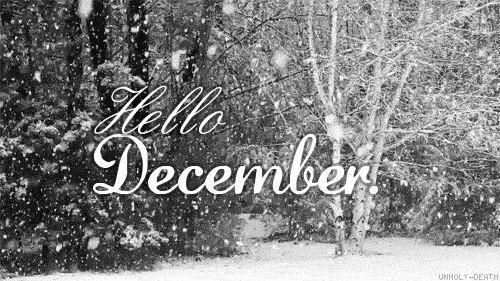
DECEMBER
REMEMBRANCE FOR EGILL SKALLAGRÍMSSON
9th December
Origins: C10th CE
Observed by: Heathens, Ásatrú, Norse pagans
Day celebrating the poet, farmer, and berserker Egill Skallagrímsson, who is recalled in The Icelandic Sagas by Snorri Sturluson. Egill is known for his many killings and escaping death by writing an epic poem after being captured when washing up on our Northumberland coastline.
SATURNALIA
17th - 23rd December
Origins: Ancient Rome
Observed by: Roman polytheists, some Hellenic
Like Yule and Lesser Dionysia, Saturnalia was the Roman winter festival celebrating the coming return of the sun and honouring the god Saturn. The standard feasting and drinking feature, and slaves would be treated as equals like Dionysia. Saturnalia is another festival cited as being picked up by Christians and used as inspiration for Christmas.
WINTER SOLSTICE (YULE/MIDWINTER)
21st December
Origins: Germanic nations, as early as C4th CE
Observed by: Norse pagans, Wiccans, Neopagans, LaVeyan Satanists, Ásatrú, Heathens, many Germanic nonpagan peoples
Yule is the midwinter festival known commonly among pagans as a time for feasting, being with loved ones, remembering ancestors, and looking forward to the return of the light and warmer days. Many pagans will celebrate Yule for more than one day, some celebrating a week either side, some for longer, up to two months, and some for twelve days afterwards. True Yule would have originally been in January for midwinter, but King Haakon the Good
moved it to coincide with the Christian celebrations in the 10th century, as told in the Ynglinga Saga.
On the 24th of December, Anglo Saxons are said to have celebrated 'Mothers Night' honouring female ancestors.
RURAL/LESSER DIONYSIA
End of December/beginning of January
Origins: Ancient Greece
Observed by: Hellenic polytheists
Smaller festival honouring the god Dionysus (Greater Dionysia took place in cities at the end of winter). Feasting, mask wearing to stop distinction between classes so that everyone could feel equal, sacrifices, parades, and phallic display were all used to celebrate.
#wheel of the year#wiccan#pagan#heathen#greek#mythology#holidays#religious holidays#pagan holidays#non-Abrahamic holidays#witch#witchcraft#witchblr#pagan wicca#polytheism#paganism#witches#witch holidays#witches holidays#pagan witch
50 notes
·
View notes
Note
I’ve been a big fan of northern fantasy, but especially viking sagas, epics and of course the Eda, are there any games that fall into genres similar to the Volsung Saga or The Epic of Ragnar Lodbrok?
THEME: Viking Sagas
Hello! The following recommendations are either based on Norse Fantasy, Viking Fantasy, or historical Norse societies. Some are more realistic than others, but they run the gamut from light-hearted to serious, and from fantastical to realistic.







9 Lives to Valhalla, by Gem Room Games.
9 Lives to Valhalla is a frenetic, gleefully ultraviolent ttrpg about death metal viking cats earning their seat in Valhalla through glorious violence and death (all 9 of them)!
Nine lives to stalk the earth! Nine times to die with sword in paw! Nine Lives to Valhalla!
You are a death metal viking cat, earning your place in the drinking halls of Valhalla by casting a wake of blood and carnage upon the blighted earth in each of your 9 lives. Guided personally by DEATH, your merry band will leave a wake of ruin ending only at the hands of a truly worthy foe. Find treasures, trade with merchants, mercenaries, or ghosts, and follow DEATH to seek worthy foes, fiendish traps, and ensure your place among the greatest warriors of catkind!
This is absolutely the kind of game you want to pull out for players who want to dive into violence with glee. This is a death-metal dark-fantasy world, with dangerous opponents, a pantheon of cat gods, tons of character abilities, and GM advice on how to design your own foes on the fly. If you want a game that indulges a party of murder hobos and sends nods to the pop-culture tropes of Vikings, you might want to check out 9 Lives To Valhalla.
Ydalir, by Loreshaper Games.
Ullr took something that is rightly yours. He reigns in his court, Ýdalir, and that is where he has taken your treasure. It may be your beloved, a prized possession or tool, or even your honor—and you will get it back.
One player will take on the role of GM. They will guide the saga as it unfolds. They will tell players when to roll, and what the threshold is. The other players will make heroes seeking to reclaim what Ullr stole from them—they may be after the same object or several different things, but getting them back is a shared quest.
This is a one-page bluffing game, in which you don’t have to tell the truth about what you rolled. However, other players can take on the role of Ullr call your bluff. If you lied (or failed), you suffer a Loss, while if you tell the truth, you gain a Focus, which forces other players to tell the truth, or reveal their next roll and gives your player a step up in the future. If you like the idea of characters bluffing their way past a God to get their treasures back, or you just want a small game interacting with Norse mythology, you might want to check out this game.
Runecairn, by Odin’s Beard RPG.
In a long forgotten age, a raging war shattered and devastated the worlds of gods and men. Now green life blooms amidst the ruins of the lost worlds. Wondrous and terrible beings roam the Nine Realms. Civilization stumbles forward, fresh and reaching.
Strap on your bearded axe and linden wood shield, delve into the forsaken barrow and cleanse the draugr within. They will overwhelm you at first so prepare to die. But when you wake up at the bonfire, you'll know what to expect for your next attempt. Parry their attacks, disarm them, and hack them to pieces. Defeat the mad jotunn within and claim the soul remnant they protect.
Death is not the end.
Runecairn: Core Rules is a 44-page, black and white tabletop RPG zine, which includes a Norse fantasy setting, a full game system, and character creation rules for adventures set after Ragnarok destroyed most of the Nine Realms of Norse mythology. Runecairn is based on Cairn by Yochai Gal, with streamlined rules, fast character creation, and gameplay based on exploration and player choice.
This game is designed for the OSR gamer, which means that death is likely and character creation is quick. This game has quite a few supplements that you can pick up to enhance your play, from the Advanced Rules, (solo play, advanced character options), Beneath the Broken Sword (an introductory dungeon crawl), and Wardensaga, a package that contains everything in one place. If you’re interested in a rules-set that is easy to pick up and carries time-honoured nods to the fantasy game, with a Norse Mythology twist, I recommend Runecairn.
Blood Feud, by Bläckfisk Publishing.
Blood Feud is a game about toxic masculinity: certain common attitudes and behaviors among men, that cause great harm to them and to others around them. This is a game about people being nasty to each other and about figuring out why.
It’s also a game about vikings of pre-christian Scandinavia; about honor and blood feuds, courage and brutality, corruption and consequences. Above all it is a game about what it means to be a man in such a world—and what consequences that has on the communities they live in.
The goal of the game is to explore and experience toxic masculinity, while at the same time creating a thoughtful drama about relationships, competition and social consequences. Blood Feud is decidedly different from the other games on this list in that it takes away fantastical elements and focuses on the intertwined relationships of Vikings through a critical lens. It does this using the well-matched Powered by the Apocalypse system, which is a hallmark for dramatic role-players. If you’re interested in Viking life as well as exploring public and private relationships, you should absolutely check this game out.
Iron Edda: World of Metal and Bone, by Tracy Barnett.
Dwarven Destroyers stretch shadows across Midgard, a harbinger of war to come. Brave human warriors abandon clan and holdfast to bond themselves to the bones of dead giants, hoping to push back the Destroyers. Strangers from others lands appear in Midgard, bringing with them strange powers, and tales of war abroad.
Seers advise and divine the future, but the fate of the world is murky and dim. Jarls, thralls, and warriors fight in common cause, shouting “victory or Valhalla!” as they charge into battle. Ragnarok has come, and you live in a World of Metal and Bone. Will you dine with the gods in Valhalla, or dance with the dishonoured dead?
Another Powered by the Apocalypse game, World of Metal and Bone lets you tell stories of brave warriors, Jarls, Bone-bonded giants, and their defense of their holdfasts. Based on Dungeon World, this game includes something that not a lot of PbtA games have - established lore. There’s not much of it, but characters are presented with names that follow the naming conventions of different cultures and locations, and the book begins by presenting the reader with different factions and neighbouring countries.
If you’re interested in this setting but you would like a different system, Iron Edda Accelerated is in the same world but uses the FATE rules system instead. There’s also Iron Edda Reforged, a side-story game about building a neighbourhood community and taking down the gods - although this is less Norse Mythology and more a modern-day post-apocalypse.
Godtale, by Bläckfisk Publishing.
GODTALE is a Norse mythological micro RPG about escapades and rivalries, about cunning and vainglory. You portray aesir, asynjur and vanir of your own creation. Together you go on adventures in the Nine Realms. But each of you wants to be the deity who earns the most glory—not infrequently at the expense of your companions.
Godtale is a game in which you can win or lose. You will compete against your fellow players to gain the most Glory by the end of the game. You do so by overcoming Trials, using your Domains, Attributes, and Possessions to do so. You must also be careful not to accumulate too much Pride, which will negatively affect your dice rolls.
As for the GM, this little game provides a few pieces of advice on running the game, as well as some roll tables to give the characters interesting Trials. Overall, this game is quick, simple, and a great way to establish new myths about the deities of the Norse Pantheon - maybe even a great way to set the stage for another game on this list!
In The Time of Monsters, by Possum Creek Games.
It was the final age — the old world was dying, and the new world was struggling to be born. Every day Ragnarok drew closer, the end of the world heralded by churning seas and raging skies. The gods grew rotten and weak, their greedy eyes sunken into rotting skulls. The great heroes were reduced to grist in the mill of war. It was the final age before all things ended, and as the world-tree rotted, everyone knew … Now is the time of monsters.
In The Time Of Monsters is a tactical combat TTRPG about bloodsoaked heroes vying for power at the end of the world. It's inspired by Norse Mythology, Lancer, and Dungeons & Dragons 4th Edition.
Jay Dragon is more known for games that are diceless or centred on storytelling, but this game seems to be a divergence from this pattern. This is meant to be tactical, it’s meant to be combat-focused, and it carries the familiar character elements of stats, special abilities, and inventory. That being said, characters will also answer questions about where they got their weapons and magic items and what they want in regards to the end of the world.
If you're looking to tell dramatic fables about tragic warriors on a grid while rolling dice and getting big numbers, this is the game for you. If you’re looking for an adventure to drop into this game, you can check out Ullr’s Revenge, a third-party supplement written by Ripley Caldwell.
65 notes
·
View notes
Text

Ivar the Boneles
Ivar the Boneless was a Viking warrior and ruler who lived in the 9th century AD. He was a son of the Viking king Ragnar Lodbrok and played a prominent role in the Viking invasions of England and Ireland. Ivar's nickname "Boneless" is believed to be a reference to his illness, which left him unable to walk. He is also said to have had a reputation as a formidable warrior and a skilled commander in battle. Ivar's story is known from Norse sagas and legendary sagas.
18 notes
·
View notes
Text
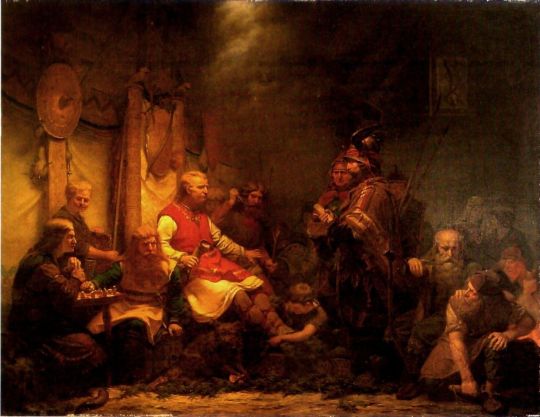
Today, Mar 28 our Fun #Norse Friends and by many contemporary #Scandinavians would have been getting down with #RagnarLodbrok Day!
(https://en.wikipedia.org/wiki/Ragnar_Lodbrok)
Painting:
Saga om Konung Ragnar Lodbrok och hans Söner
by Carl Gustaf Kröningssvärd
1834, oil on canvas
0 notes
Text
Skalds, DNA, and a Winter So Cold It'd Freeze Your Horns Off: Ragnar Lodbrok Spills the Mead on Our Ancestors' Epic Survival
Ahoy, Tumblr kin! Gather 'round our digital campfire, for we've got a tale that'll make your modern-day struggles look like a walk in Valhalla. You see, Ragnar Lodbrok here, yes, the Viking hero of old, has taken a break from raiding to narrate a saga so epic, it'll make your ancestors' bones rattle with pride.
Picture this: 900,000 years ago, Earth was gripped by a winter so brutal, it made Jotunheim's frost giants look like icicles at a summer feast. Our ancestors, those plucky predecessors of ours, were facing a deep freeze that could freeze the blood in their veins. Not your everyday chill, but a freeze that would make the bravest warrior shiver in his fur boots.
You're probably scratching your head, wondering how a battle-hardened Viking like me knows about such ancient times. Well, I've been chatting with some scholarly types, like Nick Ashton and Chris Stringer. These brainy warriors have been scouring the past like I've scoured seas, using their smart-people tools to uncover secrets about this icy epoch.
During this frosty era, known as the Middle Pleistocene transition, our world transformed into a frozen wasteland. Forests bowed to the relentless march of ice, and creatures either adapted or kicked the bucket. Our ancestors, a hardy bunch, but not quite Vikings, were a leaner breed of human, struggling to survive in a world turning against them.
Ashton and Stringer, these scholarly heroes, say this merciless winter caused a 'population bottleneck.' Imagine trying to pour mead through a narrow horn, and only a trickle gets through. That's what happened. Their numbers dwindled, squeezed by the frosty grip of this endless winter, until there were only about 1,300 breeding warriors and shieldmaidens left.
These few, these brave few, clung to life like barnacles to a longship's hull. For almost 120,000 years, they battled this frigid foe. This wasn’t a battle of axes and swords, but of will, grit, and a burning desire to survive against the odds.
What's more, this chill left its mark on us, in our very genes. These modern-day seers have used FitCoal (Fast Infinitesimal Time Coalescent) magic, reading the runes hidden in our DNA to find traces of this struggle for survival.
So, raise your horns to those ancient warriors of survival. Their battle against a winter that would chill the bones of Ymir himself is a story we should never forget.
Now, let's talk about FitCoal, the seer’s tool more cunning than Loki. It's a method to peer deep into the past, using our genes. Think of it as a longship, not with oars and sails, but with the power to voyage back through the murky seas of time.
FitCoal is like having the sharpest-eyed raven in the skies. It looks at the patterns in our DNA and relays dispatches of our ancestors. They found that our forebears' numbers dwindled down to a mere 1,300 souls. For 120,000 years, they clung to life, their numbers as scant as leaves on trees in the dead of winter.
But how did these transformations occur? It was the result of unflinching pressure, the kind that turns coal into diamonds. This period of hardship may well have been the forge in which the chromosomal fusion, a hallmark of our species, was crafted.
Our ancestors' trials shaped our genome, carving out traits that would see us thrive in a world that was constantly shifting. Our capacity for adaptation, our unparalleled knack for survival, is their gift to us.
The future skalds, the scientists and storytellers of tomorrow, have yet to write their revelations, their discoveries yet to be told. The scripts of the past are a guide; it's their hand that will carve the scripts of the future.
So, there you have it, Tumblr folks. A story of survival, resilience, and icy battles that makes your winter woes look like a tropical vacation. Skål to our ancestors, the true heroes of humanity's saga! 🍻🗡️🛡️
0 notes
Photo

Viking raids and their threat were significant factors in the establishment of the later Normans. The Vikings, known for their seafaring abilities, launched several attacks on Paris, including a major attack in which they successfully captured the city. These raids were often carried out using ships that could navigate the rivers, such as the Seine, to reach their targets.
In response to these Viking raids, the French king sought to defend against future attacks by employing Norsemen to guard the entrance to the River Seine in what is now known as Normandy. The king offered the Norsemen land and other valuable incentives in exchange for their services. This arrangement eventually established the Duchy of Normandy and the subsequent Norman conquest of England in 1066.
The Viking raids on European cities, including Paris, were not only driven by a desire for plunder but also had political motivations. The Vikings sought to punish European powers and disrupt their control, including the spread of Christianity. These attacks were often retaliatory, triggered by conflicts and actions by European rulers against the Vikings.
Ragnar Lodbrok, a legendary Nordic king, is mentioned in Norse poems, sagas, and contemporary sources. He is described as a member of the Ynglinge family and the son of Sigurd Ring, a Norwegian king based in Sweden who supposedly conquered Denmark. While the tales surrounding Ragnar Lodbrok are shrouded in legend, they reflect the historical interactions between Nordic and European powers during the Viking Age.
Charlemagne, the Frankish king, Lombard king, and Roman emperor, reigned from 768 to 814. His rule was characterized by extensive conquests and military campaigns. In 772, Charlemagne launched an attack against the pagan Saxons, who resided around the Weser and Elbe rivers. Towards the end of his reign, Charlemagne took measures to protect his empire from Viking expeditions and the associated dangers. He stationed fleets along significant rivers and organized coastal defences as a preemptive defence against Viking raids.
These historical events highlight the complex interactions between Viking raiders, European rulers, and the subsequent establishment of Norman power in the region. The Viking raids played a crucial role in shaping the political landscape of Europe, leading to the establishment of new territories and the eventual Norman conquest of England.
1 note
·
View note
Photo
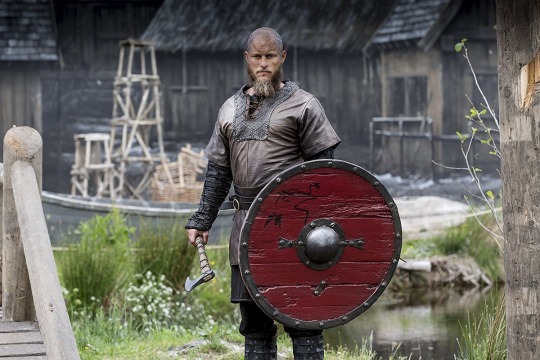
Ragnar Lothbrok
Ragnar Lothbrok, (o también Ragnar Lodbrok, del nórdico antiguo Ragnarr Loðbrók), cuyo epíteto era "pantalones peludos" o "pantalones melenudos" fue un legendario rey vikingo de las antiguas leyendas o sagas de poemas nórdicas, y otras fuentes latinas medievales hablan de sus logros en Escandinavia, Francia y en la Inglaterra anglosajona durante el siglo IXd.C. Los puntos coincidentes con frecuencia en estas historias son sus matrimonios con Thora y Aslaug, así como la paternidad de muchos hijos famosos, incluidos Ivar el Deshuesado, Bjorn Brazo de Hierro, Sigfrido Serpiente en el Ojo, Hvitserk y Ubbe. En la Gesta Danorum del siglo XIII, que trata sobre la historia danesa, se habla sobre Lagertha, una posible tercera esposa, al igual que de Swanloga, una cuarta esposa.
Lire la suite...
1 note
·
View note
Text
FATHER : Collecting research to build the name, attributes / traits, history and setting (back story)
CHARACTER 1 : Father (Homeowner)
For this, I decided to look into the actual lives of male Vikings and Viking fathers to collect research and to take inspiration from. As most historical figures I found had similar stories and was described to have very similar attributes, I tried to look for ones that stand out and seemed more interesting, and below are what I found.
1. Name: "Ragnar Lodbrok" (Shaggy-Breeches)
Ragnar is known to have had three sons: Halbdan, Inwaer (Ivar the Boneless), and Hubba (Ubbe).
Attributes/Traits:
Fierce warrior and leader
Known for his long, shaggy breeches, which earned him the nickname "Lodbrok" (Shaggy-Breeches)
He is also for his many wives and children, including the famous Viking warrior, Bjorn Ironside
Cunning and ambitious
History:
According to legend, Ragnar was a legendary Viking ruler and warrior, who lived in the 9th century.
He is said to have been a great leader and a fierce fighter, who led many successful raids on England and France.
He is also said to have been captured and killed by King Aella of Northumbria, who threw him into a pit of snakes as punishment for his raids on England.
Setting:
Ragnar's story takes place in Scandinavia and England during the 9th century.
During this time, the Vikings were known for their seafaring and raiding, and were feared for their fierce warrior culture. The setting of Ragnar's story includes both the rugged and wild landscapes of Scandinavia and the more civilized and orderly societies of England and France.
(sources: www.historic-uk.com, www.worldhistory.org)
2. Name: "Erik the Red"
Attributes/Traits:
Brave and adventurous explorer
Known for his red hair and beard, which is where he got his nickname, "Erik the Red".
Known for his leadership skills and his ability to establish a settlement in Greenland despite the harsh living conditions.
He is also known for his strong sense of determination and his willingness to take risks and explore new territories.
History:
Erik the Red was a Norwegian Viking explorer, who is most famous for being the first European to discover and settle in Greenland.
He was born in Norway but was exiled from the country for manslaughter. He then settled in Iceland and later discovered Greenland in 985.
He led a successful colony in Greenland and became a respected leader among the settlers.
Setting:
Erik the Red's story takes place in Norway, Iceland and Greenland during the 10th century.
During this time, the Vikings were known for their seafaring and exploring, and were interested in new territories and trade opportunities.
The setting of Erik's story includes the rugged and cold landscapes of Greenland, the relatively more settled Iceland and the more civilized society of Norway.
3. Name: "Halli the Fool"
Attributes/Traits:
Halli is known for his foolishness and lack of common sense.
He is also known for his clumsiness and tendency to make mistakes.
Despite his shortcomings, Halli was well-liked by his fellow Vikings for his jovial and good-natured personality.
History:
Halli was a Viking warrior who lived during the 10th century.
He is mentioned in the Norse sagas, where he is portrayed as a bit of a buffoon and a source of comic relief.
He is said to have been a member of the herd, a group of warriors who served a chieftain, and accompanied him on various raids and battles.
Setting:
The research found to be about Halli is extremely low but Halli's story takes place during the Viking Age, in various locations throughout the Viking world. He is said to have participated in raids in England and Scotland, as well as battles against other Viking groups.
4. Name: “Egil Skallagrímsson”
Attributes/Traits:
Egil was known to be fiercely independent and headstrong.
He had a fierce temper and was quick to anger, but also had a strong sense of loyalty to his friends and family.
He was a skilled warrior and feared berserker on the battlefield.
Despite his reputation as a fierce warrior, he was also known for his poetry and his love of skaldic verse.
He was also known for his drunkenness and wild behavior.
History:
Egil Skallagrímsson was a 10th century Icelandic warrior and skald (poet).
He was the son of Skalla-Grímr, a powerful chieftain in 10th-century Iceland.
He was also known for his poetry and his love of skaldic verse. He composed poetry to honor his friends and to mock his enemies.
He was also known for his drunkenness and wild behavior, and was said to have committed many deeds which were considered foolish.
(source: https://www.sagadb.org/egils_saga.en, “Egil Skallagrimsson and the Viking Ideal” by Christina von Nolcken, from the University of Chicago)
5. Name: Sweyn Forkbeard
Attributes/Traits:
Sweyn was known for his imposing figure and physical strength, but also for his love of practical jokes and pranks.
He was also known for his fondness for drinks and hearty laughter.
Sweyn was a powerful warrior and leader, but also had a reputation for being something of a jester among his men.
(source: https://www.historic-uk.com)
. . .
That concludes my research on male Vikings and Viking fathers I did in order to create my own character who will be a Viking father of two. You will surely be able to see inspiration taken from these attributes and history when I’m designing my own character.
0 notes
Photo


I desire my death now. The Disir call me home, whom Herjan hastens onward from his Hall, to take me. On the high bench, boldly, hope of life is lost now - laughing shall I die!”
485 notes
·
View notes
Text
Always thinking about and trying to understand the meaning of Aslaug’s tear....
I’ve read different analysis about depictions of women’s grief in sagas. One thing that’s interesting is tears as a performance vs as an uncontrolled outpouring of emotion. As in.... Hildigunnr (Njals saga) performs her grief by weeping in front of Flosi in order to get him to take vengeance vs Gudrun (Volsung saga) waking up and seeing Sigurd dead and weeping is a more uncontrolled outpouring of shock and grief. I think that in both cases the grief is real, the difference is whether there is additional motive in expressing it (it serves a function other than demonstrating the level of grief) and a level of control in expressing it. In that context Brynhildr’s tears in the Volsung Saga are especially interesting, because you could read them as both. When I read it, I saw her laughter turning into tears as uncontrolled, she’s unable to repress her sadness at Sigurd’s death. But I read a paper, (Strengði hon elfi: Female Reactions to Male Violence in Eddic Heroic Poetry by Caroline R. Batten) which IIRC talks about how Brynhildr’s laughter and tears serve a purpose to validate her position. Her laughter is meant to express that she has been avenged for Sigurd’s broken oaths, while her tears express her position as the grieving spouse and she’s claiming that position in order to validate that she was right to take revenge. Seemingly contradictory emotions validating each other and mirroring the interplay of love vs honor... it’s quite fascinating. (I’m probably butchering the argument in the paper... I probably should have reread it because it has been a while. But you know.... this is just a ramble on tumblr so like... yeah.)
Right, back to Aslaug... Aslaug is so interesting because her one expression of grief is so unlike other expressions of grief I’ve read in sagas (that doesn’t mean similar expressions don’t exist... obviously, just that I’m not aware of any). A single tear as red as blood and as hard as a hailstone... it’s very easy imo to read it as a controlled expression of grief I think. It is after all, just a single tear, rather than a huge lament. But... if it is a performance, then what is it a performance for? This tear is shed while her husbands and sons are away, it is not expressed in order to convince them to take revenge. Perhaps it is an uncontrolled expression of her grief... it would suit Aslaug in some ways, who demonstrates so much control and fortitude in all of her actions, to only be able to express the depth and complexity of her emotions in a single tear (albeit a tear with otherworldly qualities).
But Valkyrie by Jóhanna Katrín Friðriksdóttir, raised an interesting point:
Meanwhile, at the battle, one of the stepsons utters a verse as he lies dying, lamenting that he has no mother to grieve him after his death. But there is something to comfort him: he claims he is certain Áslaug will not be indifferent to his killing. Just before the stepson gives up the ghost, he sends his messengers back home with a ring and instructions to recite the poem to his stepmother, effectively challenging her to be a true mother to him. Áslaug receives the news of her stepsons' death sitting on the throne, combing her hair, but we ought not to let her decorous appearance deceive us. She promptly reveals her bellicose nature by declaring that she "will not hesitate to encourage vengeance for them as if they were my own sons", and her subsequent revenge campaign demonstrates that she is a worthy successor of two of Norse legend's foremost heroic characters.
So, if we look at Erik’s last words as a challenge for her to be a true mother... obviously Aslaug fulfills them by promising to pursue vengeance. But perhaps her tear is meant to fulfill his challenge as well? To prove that she is a true mother to him, that he does have a mother who is grieving for him. They don’t share blood, but her tears are still bloody.
I think a lot can be read into the fact that this is meant to be the only tear Aslaug ever sheds in her life. She doesn’t even cry at the news of her youngest son’s death, but she will cry for Erik. I mean... my man Paul Herrmann wrote that it indicated a mutual romantic love between the two of them. Because how else do you explain why she grieves for one son (and of course a lot is made of the fact that it’s a stepson at that) and not the other? But I think in this context, if we read Aslaug’s grief as a part of her fulfilling Erik’s last requests... then it’s not necessarily that she grieves for one son and not the other. It’s that she’s purposefully showing her true feelings in one case and hiding them in others.
I get that... well, I’m using one instance of emotion as a case to try and show that there’s emotion even when she’s not showcasing it. I get it, my logic is maybe it a little backwards and weird. But...I don’t know, Aslaug faces so many events and always displays this level of fortitude and strength, it’s easy to think that this is exactly how she feels on the inside too. But perhaps Erik’s challenge (if we choose to read it as a challenge) and her fulfillment of the challenge (if we choose to read her tear in that way) also grant Aslaug freedom to showcase her emotions rather than constantly keeping them inside.
#text#the saga of ragnar lodbrok#aslaug#.... yes I'm tagging this so people can call me out if I'm being ridiculous#... still don't understand the blood being as hard as hail#working on it working on it#and by understand... I mean that I've come to some personal interpretation of its meaning#obviously I'm just a person
8 notes
·
View notes
Photo
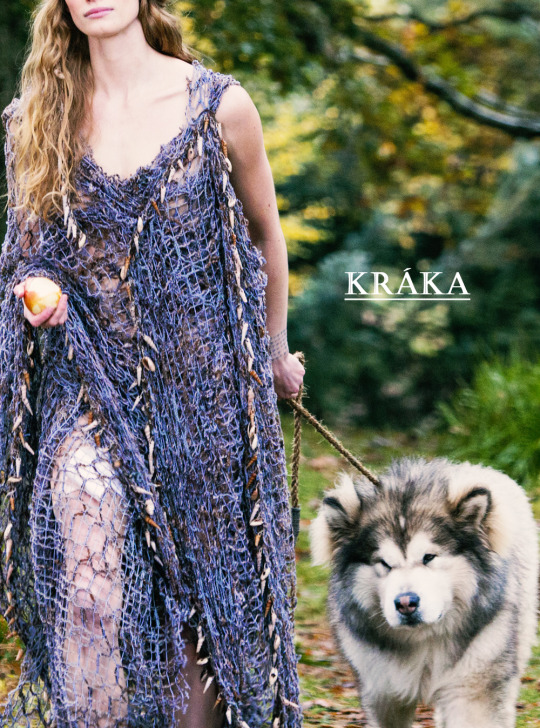


Saga-Aslaug appreciation post.
These are the three aspects embodied by the Queen of Denmark, Aslaug Sigurdsdottir, wife of Ragnar Lodbrok, in “The Sagas of Ragnar Lodbrok”
Kráka: a peasant;
Aslaug: a Queen who belongs to a divine lineage;
Randalin: a warrior; a war commander. Randalin means the "shield-maiden goddess".
69 notes
·
View notes
Text
Next in The Saxon Rose and The Ouroboros
Summary: Aella makes his way back to Northumbria with an unexpected and new ally. Blaeja and Ecgberht are afraid of what this arrival might bring.
Aella arrives. He is proud of his victory, while many of his men don’t feel so satisfied. Of course, they are happy that their families would be safe for now, but it was not an honorable battle. Osberth’s men were considered outlaw now, yet they were ambushed by Aella.
Blaeja and Ecgberht arrive in the courtyard almost at the same time as Aella. Blaeja glances at the crowd, they were delighted by the success of the king. But, somehow the mood didn’t seem the same among the army. They were quiet, head down, looking defeated.
Aella addressed the crowd. “Today we won one of Northumbria’s toughest battles. We have many battles to come, because the pagans are like a plague that doesn’t promply cease. Sadly, Osberth’s fell. By the treachery of the heathens. His last will was to his men to keep loyal to me. Yet, his cousin took advantage of the situation to try a coup. He will start spreading rumors that I’m involved with Osberth’s death. They are not truth. He would be my daughter’s husband. They were betrothed by the laws of the Church. It would be a grave sin to attempt against his life. So, I recommend anyone who hears rumors about it, to come and tell me who is spreading false stories about your rightful king.”
The crowd was whispering. Blaeja was scandalized. She didn’t want to believe her father was perfidious. It couldn’t be. Yet, the army’s mood was telling otherwise.
Aella was nervous, Osric shouted. “It was God’s will that the rightful king survived. Northumbria will not be divided again. We must find Osberth’s evil cousin and behead him for his disloyalty.”
The crowd cheered. Blaeja saw how it was easy to change people’s mind by using the right words. When Aella’s eyes met Blaeja, he betrayed himself. She couldn’t prove anything. She knew little about Osred, yet, he didn’t seem the kind of man who would betray his blood.
Aella addressed the crowd again. “We must celebrate our victory today. But let’s not forget the many battles to come. To win them once and for all, we must do things we have never tried. Northumbria has a new ally.”
This said, a Viking party makes its entrance. Ecgberht hides behind Blaeja in fear. She holds him close. The man leading the way is tall, broad shouldered. He is not riding in a common way. His horse is leading a kind of chariot. She just doesn’t know why. The man was studying the crowd with an amused smile. It was like their fear was a source of entertainment.
His eyes meet hers. Her heart sinks. Blaeja feels like she knows him. Tall and dark haired. Was it possible that she knew him?
#who is this tall and dark haired Viking?#???#the saxon rose and the ouroboros#otp: the saxon rose and the ouroboros#{{otp: the saxon Rose and the ouroboros}}#sigurd x blaeja#blaeja#vksigurd#ch: sigurd ragnarsson#sigurd snake in the eye#sigurd ragnarsson#sigurd snake-in-the-eye#vikings fanfic#The saga of Ragnar lodbrok#the tale of ragnarssons#the tale of ragnar's sons#viking age#the great heathen army#9th century#norse sagas#vikings in britain#vikings#historyvikings#vikings history channel#tv: vikings#ch: blaeja#ch: sigurd snake-in-the-eye#ch: sigurd#ch: sigurd snake in the eye#aella
5 notes
·
View notes
Photo
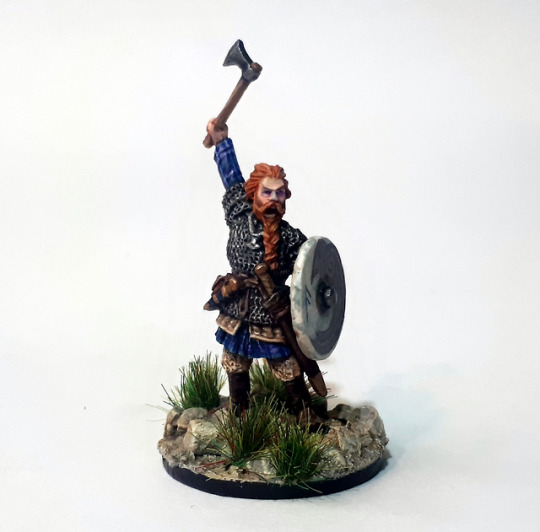


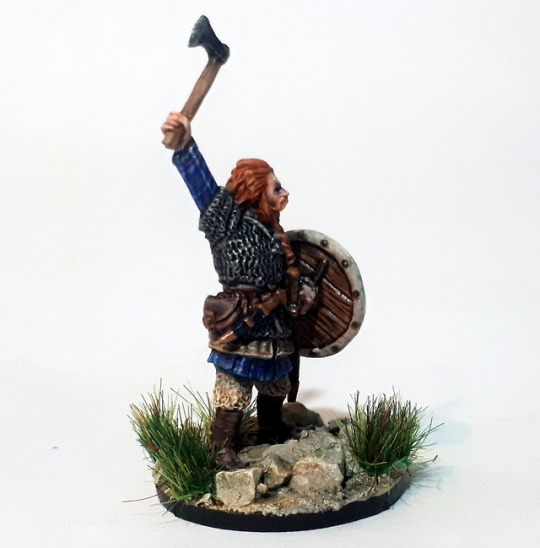

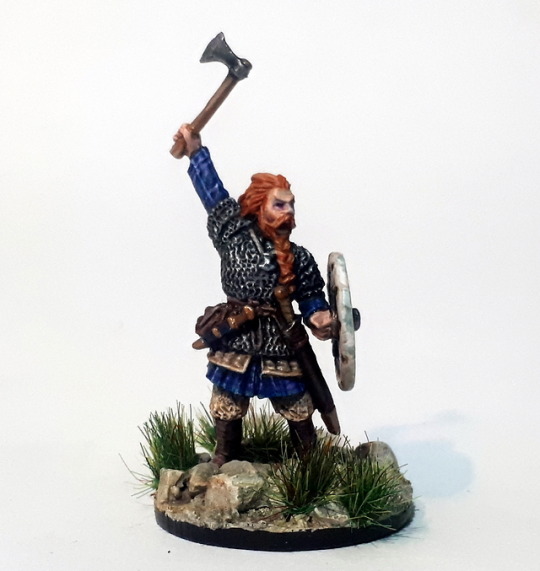
One of the most famous men to have probably never existed: Ragnarr Loðbrók.
I like me a good distraction model! Painting the weapons & armour on those gors gave me a bit of a taste for more grimy iron, so I went ahead and dug this little dude out of the shame pile. Tried my hand at a little tartan as well, for good measure (Ragnar’s not known for raiding Scotland, but then he’s not known for being real either, so ¯\_(ツ)_/¯ ). Apparently the literal translation of his name is “Ragnar Shaggy Breeches,” and someone decided to make the most of that by giving this model little woolly trousers, which I rather like.
#ragnar lodbrok#ragnar lothbrok#vikings#historical wargames#saga#swordpoint#hail caesar#2019#footsore miniatures#viking#norse#norse gael
19 notes
·
View notes
Note
hi! i really like your page, it's super aesthetic💛 also liked to ask what have you been reading lately, 'cause i need books to read!😋
You’re too nice. For books, I’m the type to read like 10 books at a time. Right now I’m reading;
“Naturally Tan” by Tan France (Memoir/Biography)
“Pride and Prejudice” by Jane Austen (Fiction)
“The Selected Poems of Thomas Hardy” (Poetry)
“The Comet in Moominland” by Tove Jansson (Children’s Book)
“The Sagas of Ragnar Lodbrok” (Folklore)
“Myths of the Norsemen” by Roger Lancelyn Green (Mythology)
Soon I’m going to start reading “The Moonstone” by Wilkie Collins because it’s like a family thing that no one has been able to read this book completely.
I’m looking for more books, so if you have any recs I’d love it!
#godzilla reads#godzilla answers#txt post#answer post#ask#book rec#currently reading#the moonstone#wilkie collins#naturally tan#tan france#pride and prejudice#jane austen#thomas hardy#the comet in moominland#the sagas of ragnar lodbrok#myths of the norsemen#roger lancelyn green
26 notes
·
View notes
Text
The gods would be proud of my Christmas/Yule haul 😎
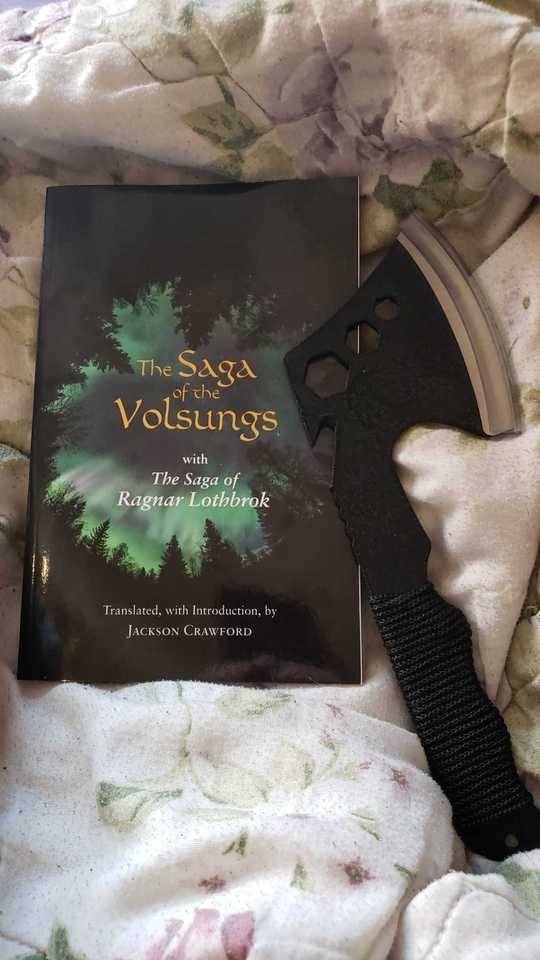
#norse paganism#norse#norse mythology#norse gods#norse polytheism#norse heathen#hatchet#jackson crawford#saga#saga of the volsungs#ragnar lodbrok#witch#heathen#pagan#green witch#thor#odin
82 notes
·
View notes